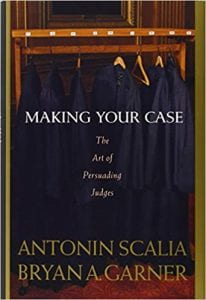
Making Your Case: The Art of Persuading Judges
Antonin Scalia & Bryan A. Garner
Date of Publication – April 28, 2008
245 pages
4/5☆
What Is This Book About?
In Making Your Case: The Art of Persuading Judges authored by former Supreme Court Justice Antonin Scalia, together with American lawyer and teacher Bryan A. Garner, readers are taught “the art” of presenting a case in front of the court. Split into four parts: General Principles of Argument; Legal Reasoning; Briefing; and Oral Argument, this book explains the process from the very beginning to the end. Scalia and Garner use a conversational tone that is effortless for readers to understand and turns information about a particularly complex skill into a pleasurable read.
What Did I Like About the Book?
First off, I appreciated the writing style of this book. Not only is it split into four sections, but it is written in a list format that makes the information clear and easy to digest. The writers first include their “tip” and then go into more detail and explain it. By doing this, it is convenient for readers to know exactly what Scalia and Garner suggest in order to persuade the judges.
In the Briefing section, Scalia and Garner write about how, as future lawyers, we must strengthen our command of written English.
“You would have no confidence in a carpenter whose tools were dull and rusty. Lawyers possess only one tool to convey their thoughts: language. They must acquire and hone the finest, most effective version of that tool available. They must love words and use them exactly.”[1]
I loved this piece. I thought the analogy was fantastic and helped the authors convey their point so clearly. As future lawyers, we must mean what we say and say what we mean – a tip that may sound obvious but is often underrated.
I also loved how their first tip for long-term preparation in arguing a case is all about being yourself. The writers talk about how everyone has a personal manner of speaking and it is a mistake to be what you’re not. Our trial advocacy professor at the Elisabeth Haub School of Law, at Pace University, Jared Hatcliffe, always encourages his students to grow into their styles. In an environment as competitive as the law and advocacy, I think it could be really easy to just lose yourself and conform to how you feel others expect you to be. So, for me, it was great to see this brought up in the book because it means it’s being taught, even in the levels competing before the Supreme Court, and this is a valuable lesson that extends beyond just our classroom where we are comfortable.
What Didn’t I Like About the Book?
Throughout the book, the only part I disliked was the Legal Reasoning section. It was quick, only taking up about 20 pages; and I know that legal reasoning is incredibly important when arguing, but frankly, I just thought this section was boring. When the authors talked about the major premise, minor premise, and conclusions, I was getting flashbacks to studying for the LSAT, and I could certainly do without those flashbacks. In addition, the book’s style during this section just got a little too textbook-like for me.
What Did This Book Teach Me About Advocacy?
As someone who can be a little too chatty sometimes, keeping it brief and straightforward is a criticism I received a lot during 1L when beginning to learn legal writing and something I still work on now when legal writing. Scalia and Garner wrote a sentence in this book that put it perfectly:
“Every word that is not a help is a hindrance because it distracts.”[2]
Besides never wanting to waste the court’s time, you want to explain your argument in the simplest manner possible. So, at least for myself, this sentence will be on repeat in my head from now on whenever I am writing or advocating.
Another essential thing this book taught me about advocacy was how important credibility is. If an advocate lacks credibility throughout their argument, their reasoning, case law, and logic all fail. This is a point mentioned numerous times starting at the outset and carried all the way through the book, so you know it was something they wanted their readers to be able to takeaway.
How Am I Going to Be a Better Advocate Because of This Book?
Making Your Case: The Art of Persuading Judges pointed out many little things that will help me be a better advocate as a whole. But after reading this book, I realized that much of the book is written on preparing an oral argument, rather than giving it. Preparation is vital during advocacy, and that is the same for law school mock trial competitions, all the way through oral arguments in the Supreme Court. It does not matter how long you have been a lawyer or how much experience you have under your belt, each case needs to be prepared thoroughly, and this was a point that hit home for me.
This book is a great read, and since I have not participated in much advocacy over the summer, it was a great way to brush up my skills. I wish I had read it over winter break during 1L, right before we entered the semester where we had our 1L Moot Court Competition because it really would have helped me understand the process as a whole and perform better. It’s a perfect book for introducing advocacy to a new learner, and I highly recommend this read.
[1] Antonin Scalia & Bryan A. Garner, Making Your Case: The Art of Persuading Judges, 61 (2008).
[2] Id. at 81.


What a fantastic review. I have been practicing successfully for 35 years and have not read this book. I’m going to read it immediately.
My office had Bryan Garner present his legal writing training more than a decade ago and I picked this book up after the training. He is very fond of Justice Scalia and wrote another book with him (I believe). If you’re interested in more from Bryan Garner, he has a monthly section in the ABA journal with legal writing tips (and I believe law students can join the ABA for free).